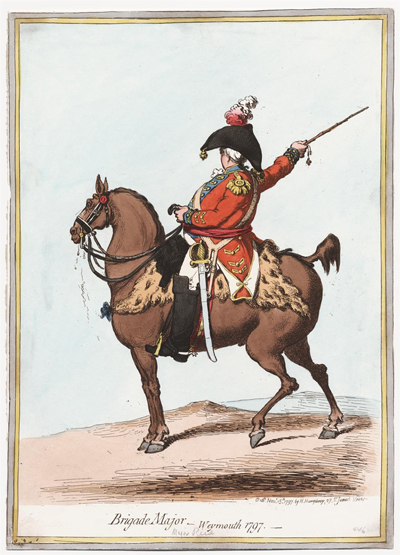Brigade-Major. Weymouth, 1797
This is one of three prints from 1797 associated either explicitly or implicitly with Weymouth where the King and the Royal Family spent their summer holiday in 1797 from the end of July 'til mid September. The other prints include The Esplanade, Patern-Staff. Weymouth, 1797.
The King had been coming to Weymouth most years since 1789, staying at the Gloucester Lodge belonging to his brother. While there, the King would enjoy bathing, theater-going, and walking the Esplanade with friends. But he would also review troops in the area and watch mock battles among the battalions quartered there. Constructed in the winter of 1796/96, the Weymouth barracks were the largest of four in Dorset, designed to acommodate "16 officers, six quartermasters, and 324 NCOs and men." as well as 392 horses. As if that were not enough, the presence of the King almost invariably drew additional troops to Weymouth during his stay.

© Beinecke Rare Book and Manuscript Library, Yale University
Brigade-Major. Weymouth, 1797 is an early instance of Gillray playing a variation on the portrait caricature tradition by placing his subject on horseback. Others include Hint to Modern Sculptors, as an Ornament to a Future Square (1796), Georgey a' Cock-horse (1796), Count Roupee (1797), How to Ride with Elegance thro' the Streets (1800), and others.
As in standard portrait caricatures, the subject of the caricature is not explicitly identified. But unlike most portrait caricatures, the clues provided in the print have been insufficient to identify him with any confidence. As the British Museum commentary states, the figure in Brigade-Major. Weymouth, 1797 has been variously identified as either Sir Harry Burrard or Major Reid.
According toWikipedia, Brigade-Majors usually held the rank of Major, but could also be Captains. Checking the List of the officers of the Army and of the Corps ... 1797, I have been unable to find a Reid that was either a Major or a Captain. However, I WAS able to find a Henry Read who was a Lieutenant Colonel under Lord Harrington (p. 49) whose troops were definitely at Weymouth during the King's visit as noted in the True Briton for August 17, 1797. I was also able to find a listing for Harry Burrard as a Captain and Lieutenant Colonel in the First Regiment of Foot Guards (p. 93) under the Duke of Gloucester. In the same volume, Burrard is mentioned as the Aide de Camp to the King which may have made his presence at Weymouth also a possibility.
Despite the uncertain identification of the subject, the image itself is quite striking, recalling in parodic form more heroic equestrian portraits like that of Velazquez's Count-Duke Olivares on Horseback or, closer to home, portraits of Charles I on horseback. The only significant caricature element is in the parallel Gillray creates between the Brigade Major and his steed. Both possess bodies larger that one would expect of such small heads. The comparison is strengthened by the way the curve of the brigade major's bicorn is echoed in the curved neck and head of his horse.
Sources and Reading
- Commentary from the British Museum on Brigade-Major. Weymouth, 1797.
- "Sir Harry Burrard, 1st Baronet, of Lymington," Wikipedia
- "Brigade," Wikipedia
- "Brigade Major," Wikipedia
- David Clammer, "Soldiers and Civilians: Troops in Dorset, 1793–1805" Journal of the Society for Army Historical Research Vol. 93, No. 375 (Autumn 2015), pp. 214-230.
- Thomas Wright and R.H. Evans, Historical and Descriptive Account of the Caricatures of James Gillray #446
- Thomas Wright and Joseph Grego, The Works of James Gillray, the Caricaturist; With the History of His Life and Times, p. 231.
Comments & Corrections
NOTE: Comments and/or corrections are always appreciated. To make that easier, I have included a form below that you can use. I promise never to share any of the info provided without your express permission.